To my mind the greatest thrill of my job comes with unearthing books or artefacts which allow us an insight into the life of their creator. Manuscripts, letters, notebooks, drawings and inscriptions offering a glimpse behind the printed words into the world of their writer, telling us about the genesis of the work, their family and the social milieu in which the author moved.
Book signings and promotional tours are a relatively modern phenomenon, thus older books with authorial inscriptions tend to have more of a personal touch. Frequently books carry heartfelt messages from the author to his friends or family or a note of gratitude to a book’s collaborator. Over the years we have been lucky enough to handle a number of wonderful association copies, some of which have required quite a bit of detective work to confirm their provenance.
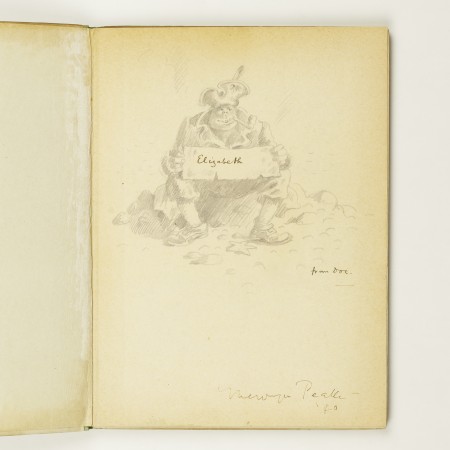
First edition of Mervyn Peake's Captain Slaughterboard with this original drawing was a gift from Peake to his Mother
As the daughter of a librarian I spent many hours of childhood curled up in a library corner, silently immersed in a book. Many of the stories I read in those hours have made a lasting impression on me, leaving a thirst to learn more about their writers; from Beatrix Potter, Roald Dahl, Enid Blyton and Rudyard Kipling in the early years to Charlotte Bronte, Aldous Huxley and George Orwell as I grew older.
So when we recently purchased a handwritten letter from Beatrix Potter to her friend and neighbour, Mrs. Wright, I was fascinated to read Potter’s comments on fellow children’s author Kenneth Grahame and his masterpiece, The Wind in the Willows. “Yes- Kenneth Grahame ought to have been an artist - at least all writers for children ought to have a sufficient recognition of what things look like - did he not describe Toad as combing his hair? A mistake to fly in the face of nature - a frog may wear galoshes; but I don’t hold with toads having beards and wigs! So I prefer Badger.”
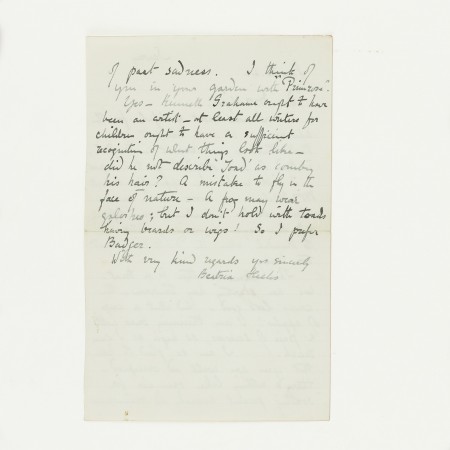
Autograph Letter by Beatrix Potter discussing The Wind in the Willows
There can’t be a child in Britain who has not experienced the thrill of reading the adventures stories of Enid Blyton. When Blyton’s own daughter, Gillian, was born Blyton wrote "...I am so pleased that a baby has come to live with me, because you all know how much I love boys and girls - and it is lovely to have one that really belongs to me and not to some other mother and father.” Over the years Enid Blyton was to draw inspiration from the experiences of those close to her, lacrosse matches, school tiffs and the intricacies of friendships all found their way into her stories. She would test out plots on her children and grandchildren and her own children’s favourite stories would often prove most popular with young readers. After Enid Blyton's death in 1968, Gillian became curator of many of her mother's belongings, including typescripts and books, her collection included books with loving personal inscriptions from her mother.
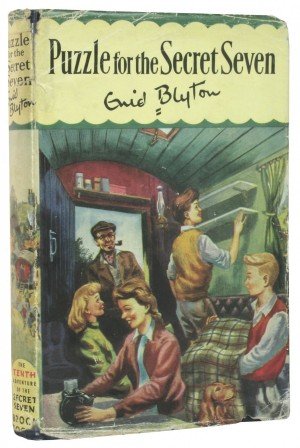
Secret Seven inscribed, "much love Granny" by Blyton
Of particular resonance is a rather worn copy of Puzzle for the Secret Seven, whose publication in 1958 coincided with the birth of Gillian’s daughter Sian Baverstock, Enid’s first grandchild. Inside the cover is printed “This book belongs to…” followed in Enid’s hand by the words, “Sian Baverstock, much love from Granny, Happy Birthday!” Sadly Sian died of a heart attack at the age of only 44 and her mother inherited this book, adding her ownership signature to the endpaper. It was to be part of Gillian’s collection for only 12 months before she too passed away and her collection was dispersed. We were lucky enough to be able to purchase this Secret Seven book and the experience of holding a book with such close family ties is very emotionally charged.
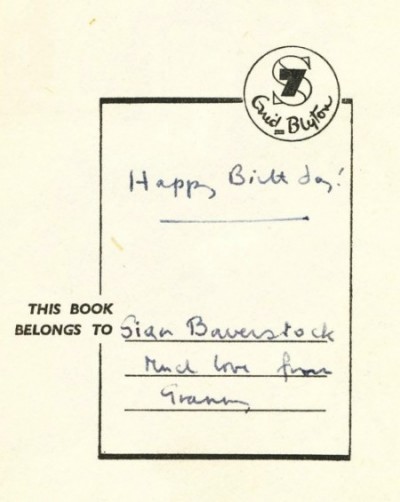
Secret Seven Inscribed by Blyton to her Granddaughter
Another favourite author of mine is Michael Bond, whose tales still make me laugh out loud. I went to see the new Paddington movie with some trepidation, but I’m delighted to report that the character and humour of the tale have been preserved and tears rolled down my cheeks throughout the movie.
Harvey Unna, Michael Bond's literary agent, was instrumental in finding a publisher for "A Bear Called Paddington" and is also the inspiration for Mr Gruber, the antique dealer in the Paddington books. "I based Mr Gruber on my literary agent Harvey Unna who fled Germany before the war," Bond says. "He used to tell me that people never recognise themselves in books and he was right; he never realised he was Mr. Gruber.”
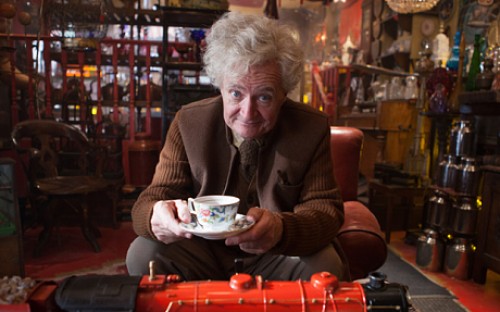
Jim Broadbent plays Mr Gruber in the recent Paddington movie
In addition to books about the small bear from darkest Peru, Michael Bond wrote a serious of comic mystery books about a French detective, Monsieur Pamplemousse (Mr. Grapefruit). As each book was published he sent a first edition to Harvey with affectionate notes inscribed in the front, "For Harvey. At last - I'm beginning to feel I'm maximising my potential!” and “Harvey, one more for your shelf!” These inscribed first editions sell for between £45 -£75, which seems quite reasonable for one of Mr. Gruber’s antiques!
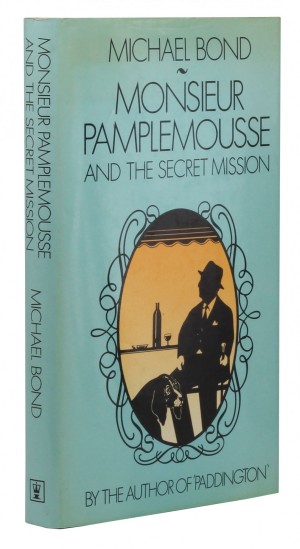
Inscribed first editions of M. Pamplemousse from the library of Harvey Unna
Some authors are in such high demand that prices for inscribed copies of their books will be more than tenfold the price of an unsigned copy. Ian Fleming, creator of the world’s most renowned spy, James Bond, was himself a flamboyant character and books given by him to friends and colleagues bear witty comments in his large, distinctive scrawl with, “To Jonathan, Who had this coming!” and ‘To Philip / Who stopped the Knave rubbing the Queen!’ All things 007 related have become collectible, but nothing is more highly prized by Fleming fans than a first edition James Bond book with a personal note from his creator.
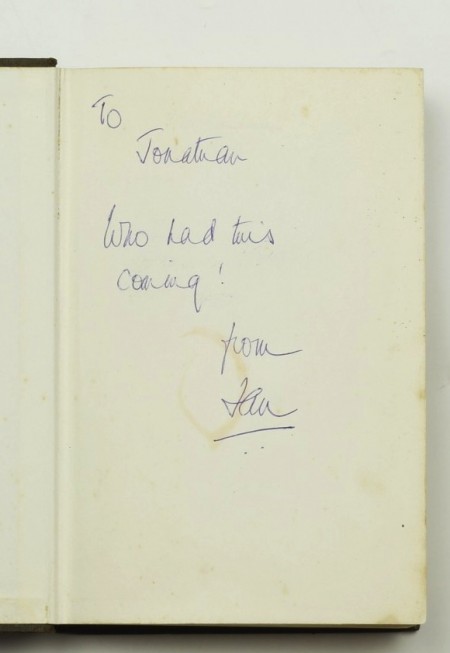
First edition of Thunderball, inscribed by Ian Fleming
Author of sea-faring yarns and thrillers, W.W. Jacobs was a contemporary of H.G. Wells, their friendship spanning many years. Over the years Wells sent many of his books to Jacobs, most bearing a brief inscription, but particularly charming was a first edition of Mankind in the Making whose inscription reads “To W.W.Jacobs / This little bale of Serious Reading from H.G.W.” The book, a series of political essays, is rather more serious in matter than his traditional science fiction novels and to illustrate the weight of the subject matter Wells has drawn a sketch of a crane hoisting a large bale of cotton, below which stands is an unsuspecting figure, labelled WWJ.
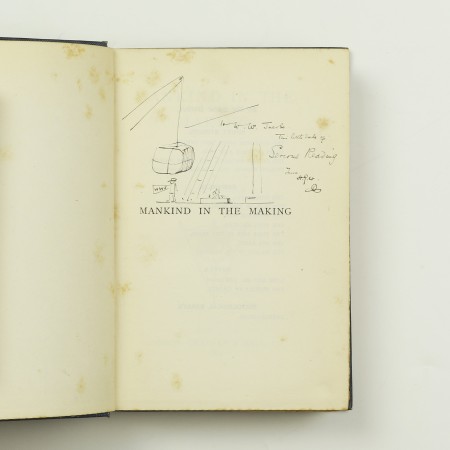
Mankind in the Making, inscribed and with a drawing by Wells
Each month we buy books or letters that tell us a story and lead us on a voyage of discovery and while there are many other advantages to life as an Antiquarian bookseller, these personal and unique finds are the thing I most prize.
Take a look at some of the other association copies we have in stock, each of them telling it's own story.
Recent Posts
- The Evolution of Crime
- Tour The Bookshop On Your Screen
- The Genesis of Mr. Toad: A Short Publication History of The Wind In The Willows
- Frank Hurley's 'South'
- The "Other" Florence Harrison
- Picturing Enid Blyton
- Advent Calendar of Illustration 2020
- Depicting Jeeves and Wooster
- Evelyn Waugh Reviews Nancy Mitford
- The Envelope Booklets of T.N. Foulis
- "To Die Like English Gentlemen"
- Kay Nielsen's Fantasy World
- A Brief Look at Woodcut Illustration
- The Wealth Of Nations by Adam Smith
- What Big Stories You Have: Brothers Grimm
- Shackleton's Antarctic Career
- Inspiring Errol Le Cain's Fantasy Artwork
- Charlie & The Great Glass Elevator
- Firsts London - An Audio Tour Of Our Booth
- Jessie M. King's Poetic Art, Books & Jewellery
Blog Archive
- January 2024 (1)
- January 2023 (1)
- August 2022 (1)
- January 2022 (1)
- February 2021 (1)
- January 2021 (1)
- December 2020 (1)
- August 2020 (1)
- July 2020 (2)
- March 2020 (3)
- February 2020 (2)
- October 2019 (2)
- July 2019 (2)
- May 2019 (1)
- April 2019 (1)
- March 2019 (2)
- February 2019 (1)
- December 2018 (1)
- November 2018 (1)
- October 2018 (2)